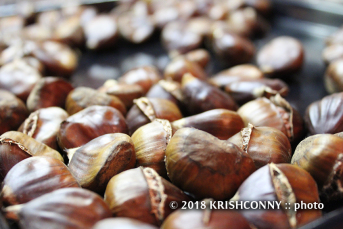 National Theatre’s Follies. All photos by Johan Persson.
National Theatre’s Follies: A Rotating Middle Aged Crisis Beautifully Losing Her Mind.
National Theatre’s Follies. All photos by Johan Persson.
National Theatre’s Follies: A Rotating Middle Aged Crisis Beautifully Losing Her Mind.
By Ross
It has been 30 years since Stephen Sondheim’s 1971 magnificent and uniquely challenging big musical had a new and full London staging (The Broadway production opened on April 4, 1971, ran for over 500 performances, was nominated for eleven Tony Awards and won seven). So it was with great fanfare when the National Theatre announced its star filled production that would grace the main stage this past fall. And what a glorious night at the theatre it is. Us New Yorkers were lucky enough to have had the opportunity to see the Bernadette Peters, Jan Maxwell, Danny Burstein, and Elaine Paige revival back in 2011 directed beautifully by Eric Schaeffer (Gigi) not to mention the 2000 revival that starred Blythe Danner, Judith Ivey, Treat Williams, and Polly Bergen. I count myself as one of the lucky souls that saw both. And now, I’m even more fortunate to include this Dominic Cooke directed revival that stars the four time Olivier winner, Imelda Staunton (Gypsy, Guys and Dolls, Sweeney Todd, Into the Woods, Who’s Afraid of Virginia Woolf?) who seems to be making her way through the American classics for the West End audiences, joined by Olivier and Obie winner Janie Dee (NT’s Carousel), three-time Olivier winner Philip Quast (NT’s South Pacific), Peter Forbes (Royal Court’s How to Hold Your Breath), and two-time Olivier winner Tracie Bennett (Regent’s Park’s High Society). This is a Follies that will be remembered, not for all their Fol- Lies, but for all the truths that these characters need to tell.
The production is as wonderful and thrilling as it sounds, expertly guided by first time musical theatre director Cooke (NT’s Ma Rainey’s Black Bottom) with a wonderfully inventive stance and perspective. Utilizing a number of compelling thematic ideas, the National Theatre’s revival is presenting a Follies that in some telling ways has not been seen or heard since the original Broadway version of the show. In 1987 for it’s London premiere, Stephen Sondheim (music and lyrics, Sweeney Todd) and James Goldman (book, A Family Affair with John Kander) revised large parts of the show’s script and score in an effort to tone down the dark ending of the Broadway original, offering up a more hopeful finale for its main characters. Cooke dives back to the original to unearth the more devastating lines said by Sally just before the final blackout; lines that have not been uttered since Dorothy Collins spoke them 40 years ago.
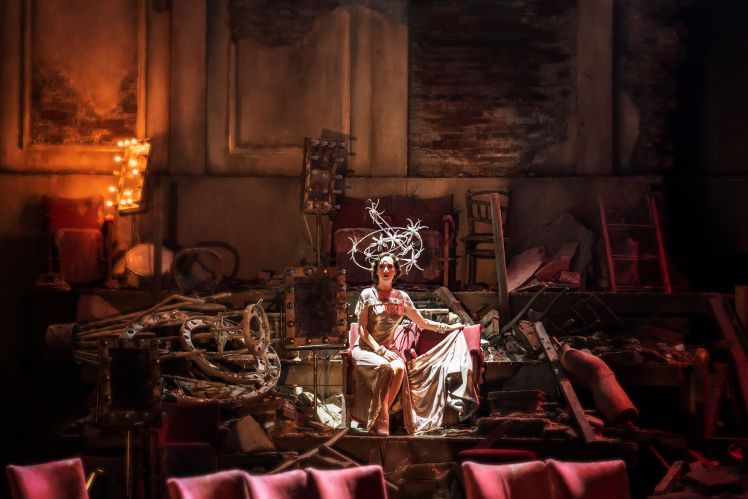
He delivers us a Follies drenched in regret and frustration, overflowing with anger and middle-aged crisis, and haunted by the dreams of the past. Impresario Weismann, played with a regal sadness by Gary Raymond (NT’s Sunday in the Park with George) introduces us to what’s in store best when he describes what the reunion of his Weismann Girls, and Follies in general, represents to himself and all his girls: “to glamorize the old days, stumble through a song or two, and lie about ourselves“. He has orchestrated a gathering in his old dilapidated Broadway theatre on the eve of its demolition with all his beautiful showgirls (based on the famous Ziegfeld Girls) assembled for one last homage to the memory of their youthful glory. Floating along side that celebration are all their memories in beautiful ghost-like form, drenched in distorted nostalgia dusted with optimism and hope, but tinged with disappointments and complexities.
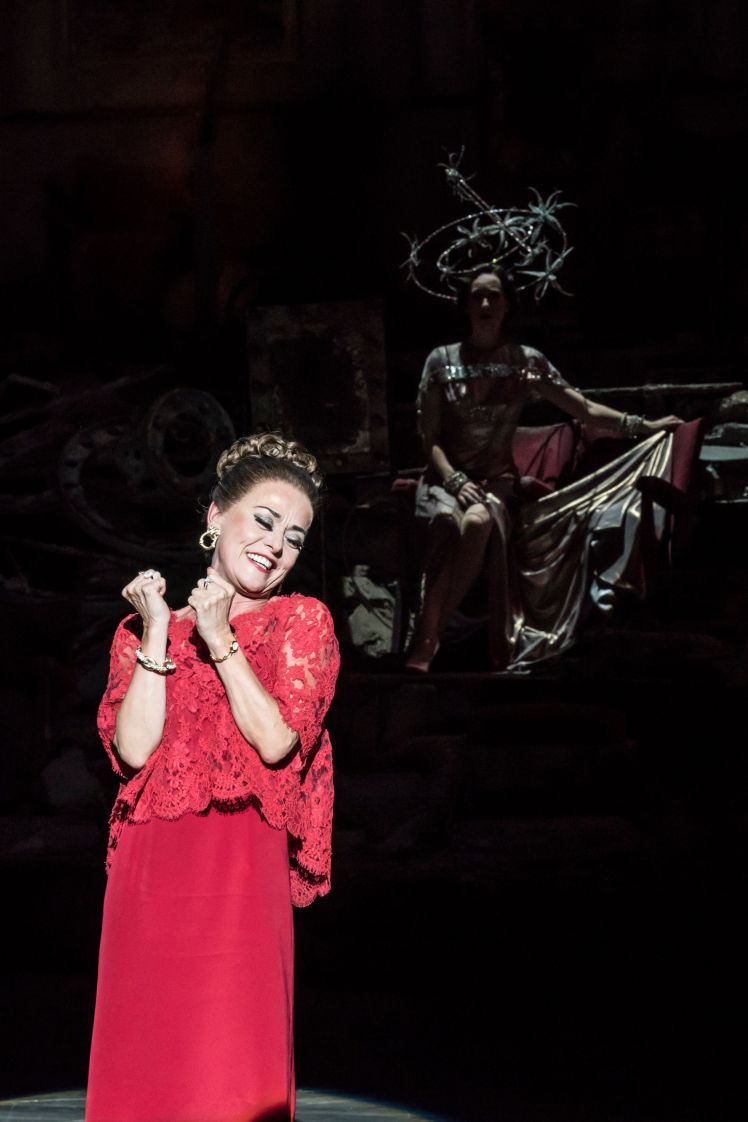 Tracie Bennett.
Tracie Bennett.
Designer, Vickie Mortimer (NT’s The Threepenny Opera) bravely knocks away the traditionalist approach to this abstractionism; demolishing the proscenium and in its place, constructing a brick wall collapsing in upon itself, stationed on a rotating stage. The wall, with a fire escape firmly attached to one side and an old sign “glorifying the American Girl”, separates the acting and party space into pockets of memories and moments; backstage and front of house; past and present; real and ghost-like, and with the help from lighting designer, Paule Constable (NT’s Angels in America) and sound designer, Paul Groothuis (Old Vic’s Design for Living) does it effortlessly. The structure and surroundings beautifully symbolizes every drop of artificial pretension and ritzy false glamour that these showgirls represent, both than and now, slowly declining into disrepair and ruin.

The soon to be torn down theatre rotates the party a-round and a-round throughout the evening’s celebration. It’s a wondrously complex backdrop to their festive reminiscing, gossiping, lies, and laughter. It pulls us in and out of their moments of intimacy, inventively weaved with the filming of a documentary-styled recording of the girls’ salutations and introspections, without ever wondering where the rest of the party has gone. In the 2011 revival, one that I loved so dearly, the party itself seemed to disappear for moments at a time, leaving us all to wonder where they went, but here in the National’s large Olivier Theatre, the party never disappears from view, making it feel so private and public all at the same time.
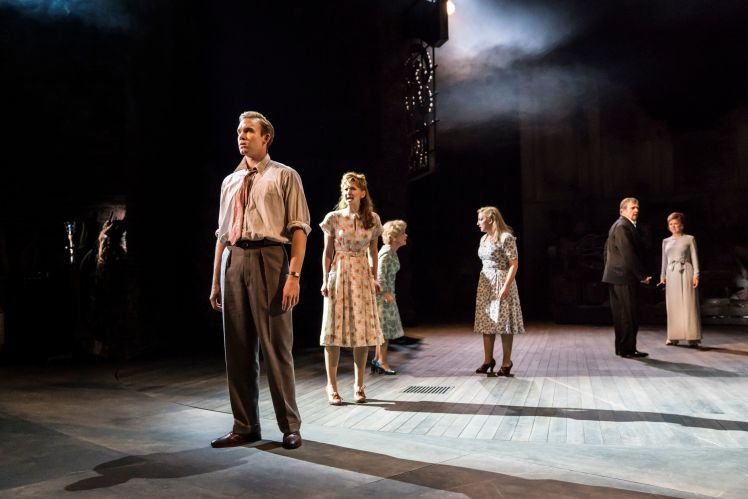 Adam Thys-Charles, Zizi Strallen, Imedla Staunton, Alex Young, Philip Quast, Janie Dee.
Adam Thys-Charles, Zizi Strallen, Imedla Staunton, Alex Young, Philip Quast, Janie Dee.
And as perfect as this scenario is, the use of the ghostly young dancers fading in and out, following themselves around, extends far beyond the opening creating another revelation in this rendition. Instead of being merely the occasional apparition reminding us of their long gone glamorous days, these ‘ghosts of dancers’ past’ lay claim to the Weismann Theatre. Perfectly coiffed in those fantastical feathered creations of that bygone time, they shadow their wistful older counterparts throughout the evening, questioning their presence at the old Follies playground. They are in attendance to see the end of this era and to see what the future has in store for them, re-enacting moments of conflict in order to push their older selves forward and away from the past.
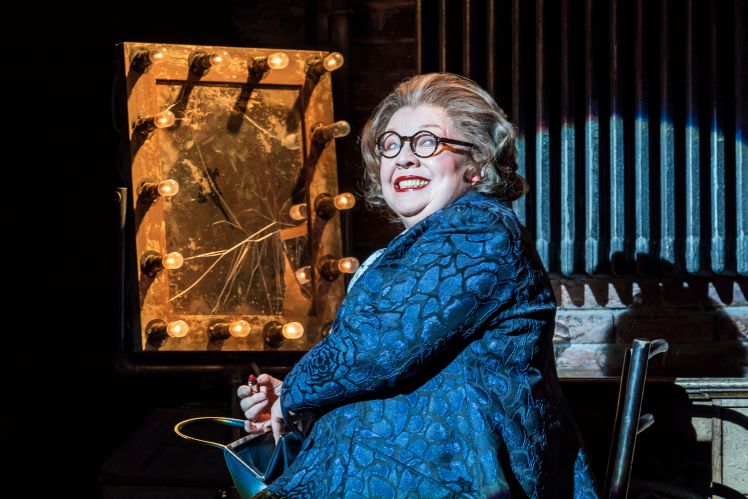 Di Botcher.
Di Botcher.
Thanks to the numerous glorious numbers from Sondheim (music supervisor: Nicholas Skilbeck; orchestrations: Jonathan Tunick with Josh Clayton; music director: Nigel Lilley), these older ladies try to connect with their former selves through songs reminiscent of their days in the theatre while simultaneously commenting on their state of affairs in the present. We are gifted by Sondheim with one wonderful hit after another, with songs such as ‘Broadway Baby‘ sung by Di Botcher (NT’s A Little Night Music) as Hattie Walker, ‘I’m Still Here‘ gloriously sung by Bennett as Carlotta Campion, ‘Ah, Paris!‘ sung by Geraldine Fitzgerald (Leicester Haymarket’s Into the Woods) as Solange LaFitte, and ‘One More Kiss‘ sung by the astounding Dame Josephine Barstow (a celebrated opera singer worldwide, singing for over 50 years) and equally talented Alison Langer (Opera Holland Park’s The Pirates of Penzance) as both the older and the younger Heidi Schiller. Telling us a tale of middle aged angst and confusion with humor and beauty all shimmering in together. One of the more fun highlights is the group dance number, ‘Who’s That Woman‘ that melts the older ladies, lead by Stella, a magnificently radiant Dawn Hope (Battersea Art Centre’s Josephine) with their younger selves. These woman relive their glory breathlessly by performing this magnificent song and dance assisted with the expertise of the young and confident dance girls. Cooke treats each lady with an enormous amount of respect, even enlisting the format utilized in the last New York revival when he allows us to be privy to watch some of the characters leaving, allowing them flashes of intimate closure as they finish their story and leave their ghosts behind.
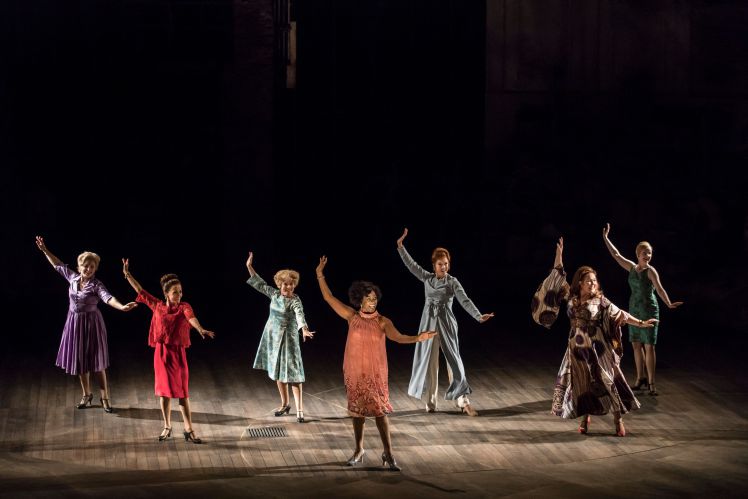 Dawn Hope (center).
Dawn Hope (center).
But Follies has another more personal dimension, and that lies in the hands of the four leads, each one contributing their own folly to the mix. I struggled in the first few moments of Follies, waiting for that initial flavorful song, ‘Waiting for the Girls Upstairs‘ that signal to me that the main construct has begun. All before seems less engaging, feeling more like a quasi-revue of an old art form, each number barely moving the plot forward, until those first words are sung by the young boys waiting for their girls. Staunton as Sally Durant Plummer (ghosted by the wonderful Alex Young) does a spectacular job filling out the desperation and distortion that lies inside Sally’s memories. Her song, ‘Losing My Mind’ is the powerhouse of the production, and even though I had a harder time connecting her to her younger dance girl-self, her breakdown and bleak finale haunts me still. Forbes as Buddy Plummer (ghosted by the strong Fred Haig) did a grand job with his two strong numbers, ‘The Right Girl‘ and ‘Buddy’s Blues‘, I had a hard time not recalling the more intense Burstein from the 2011 Broadway revival, but Forbes found his strength not so much in his songs, but in his intensely emotional connection to Staunton’s Sally. Dee knocks it out of the theatre with her well-timed humoristic delivery of ‘Could I Leave You‘ and that was even when my own memories were comparing it to the powerful Jan Maxwell performance that is lodged in my brain for a lifetime. As Phyllis Rogers Stone (ghosted by the charming Zizi Strallen), Dee gets the balance just right throughout and never makes us question her motives or actions, even when the hand is held out to her husband in the end. She’s exceptional in the jazzy dance number, ‘The Story of Lucy and Jessie‘, accompanied by a squadron of well-orchestrated chorus boys giving us both sex appeal and insightfulness. Quast also does a stellar job as husband, Benjamin Stone (ghosted by the talented Adam Rhys-Charles) especially during his epic meltdown that brings the complicated, difficult, and utterly challenging ‘Loveland‘ segment, the final musical sequence featuring a string of vaudeville-style numbers, reflecting the leading characters’ emotional problems, to a crashing close. Even when knowing what is on its way, the stuttering and collapsing of his ‘Live, Laugh, Love‘ devastates and leaves us as floored as Sally lying there distraught and feeling betrayed.
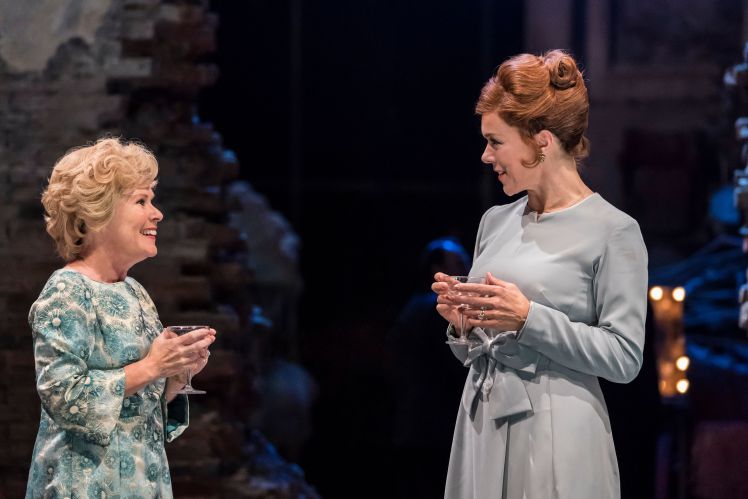 Imelda Staunton, Janie Dee.
Imelda Staunton, Janie Dee.
Earlier when the Weismann Girls make there way down the improvised staircase, cleverly staged by Cooke and stellar choreographer Bill Deamer (Aldwych’s Top Hat) to the wonderfully charming song, ‘Beautiful Girls‘, we can’t help but see the importance and deep meaning this history has melted into these older women’s souls. Their past has given them great superficial meaning to their somewhat less glamorous after-lives. But there in the back, making their mirrored way down another improvised staircase made up of rubble and discarded theatre chairs, are the spirits of their youth, brimming with hope and ideas of the future. The juxtaposition is both jaw-droopingly elegant and lovely to see, but also painful to take in, as is the whole production of the magnificent Follies. The mask of contentment held so dearly by all is as cracked as that wall, and only some will survive its eventual destruction. ‘Loveland‘, an extravagant and opulent fantasy, more gaudy than anything Weismann could have created is “the place where lovers are always young and beautiful, and everyone lives only for love” but that fantastical creation must crumble away, forcing them back to a reality that is surrounded by those equally destroyed walls of the theatre. Life will carry on, maybe etched in bleak despair, disappointment, and weary resignation that everything is not as glamorous and well put-together as a young Weismann Girl, dressed to the nines in feathers and lace, but it’s better than losing your mind.
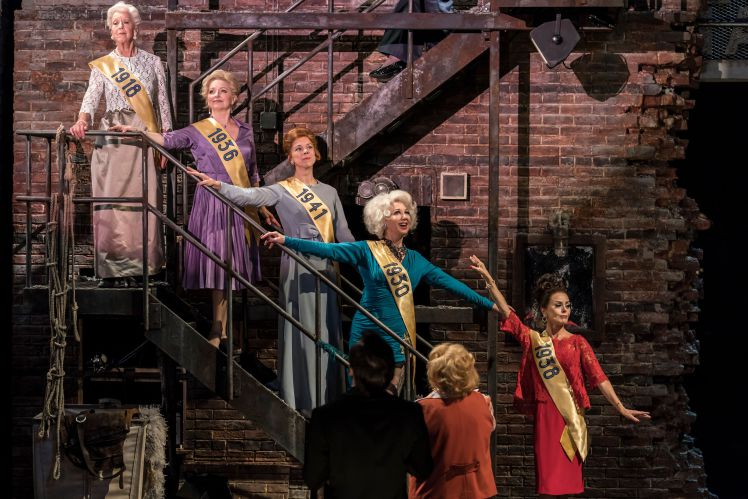 National Theatre’s Follies. Josephine Barstow, Gemma Page, Janie Dee, Geraldine Fitzgerald, Tracie Bennett. All photos by Johan Persson.
National Theatre’s Follies. Josephine Barstow, Gemma Page, Janie Dee, Geraldine Fitzgerald, Tracie Bennett. All photos by Johan Persson.
Advertisements Share this:





